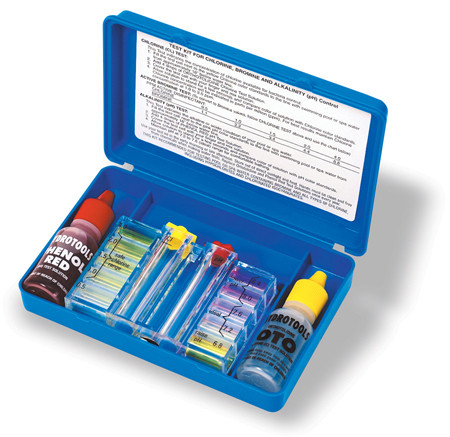Water Testing and Analysis

Test the water in your pool two to three times a week to ensure an optimum swim environment and a long life for your pool. For the best sample of water, collect from the deep end of the pool – collecting at least eight ounces of water. You can collect the water in a sample bottle or any clean, plastic container.
Testing Ranges
| pH | 7.2 – 7.6 |
| Total Alkalinity | 120-150 parts per million |
| Calcium Hardness | 200-250 parts per million (Concrete Pools) |
| Calcium Hardness | 175-225 parts per million (Vinyl Pools) |
| Free Chlorine | 1-3 parts per million |
| Free Bromine | 3-5 parts per million |
| Metals: Copper | 0 parts per million |
| Metals: Iron | 0 parts per million |
he most important factor to your water balance is the pH. The pH sets the tone for your water and keeps it clear and inviting.
Total Alkalinity
Total Alkalinity (TA), refers to the alkaline materials dissolved in the pool water. Your water’s ability to resist pH changes depends on the alkaline material. Low TA can cause the pH to vary in and out of range. High TA makes it difficult to adjust the pH as needed.
Calcium Hardness
Calcium hardness is the amount of dissolved minerals (mostly calcium carbonate) in your water. Low Calcium Hardness can corrode equipment or etch a plaster finish. High levels can lead to cloudy water or scaling. Be sure to bring a water sample to your pool professional. They can analyze the water and provide you with the necessary instruction to ensure proper water balance and chlorination levels in your pool.
Chlorine
- To maintain the proper level of residual chlorine when bather load is heavy, shock your pool once a week with a 3 to 5 times higher than normal dose of chlorine. Do not enter the pool until the chemical level is normalized.
- Chlorine is broken down by the sun’s ultraviolet rays. Using cyanuric acid to stabilize the chlorine in your pool at the beginning of the swim season will help you maximize your chlorine’s efficiency all summer long.
- Filters remove suspended particles from pool water, but don’t control bacteria or algae. Maintain a residual chlorine level of 1.0-3.0 ppm (parts per million) to kill bacteria and/or algae present in the water.
pH Level
- The ideal pH for pool water is 7.5. A pH range of 7.4-7.6 is considered acceptable.
- Maintaining a total alkalinity (T.A.) range from 80-120 ppm (parts per million) will help minimize changes in pH, which can result in scaling and corrosion. Frequent testing can help prevent these problems before they get out of hand.
Quality
- To ensure accurate readings, replace test kit reagents annually.
- To ensure the highest water quality, test your pool’s pH and free chlorine levels daily, adding chemicals as needed.
- Proper chemical usage is important for maintaining a healthy pool. Be sure to follow the chemical manufacturer’s instructions closely regarding proper dosage for your size pool.
- Add an algaecide and chlorine to your pool before covering it for the winter. It will ensure that the water is clear and algae-free when you reopen it the following season.


